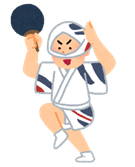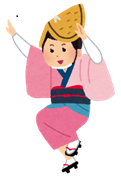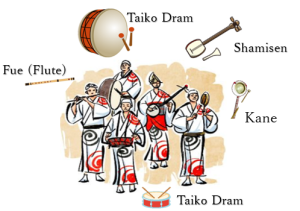LATIN “Awa Dance” 「阿波踊り」
What is Awa Odori (Awa Dance)? First, watch the royalty-free VIDEO:
(阿波踊り(Awa Dance)とは?先ずは
ロイヤリティフリーのVIDEOを見てください。
Awa-Odori, one of the most famous Bon-Odori festivals,
originated in Tokushima Prefecture and has a 400-year history.
During this traditional dance festival, participants, supported by unique
and lively musical accompaniment, showcase their skills in groups called “Ren.”
The festival takes place annually from August 12th to 15th in Tokushima City,
attracting over a million visitors from both Japan and abroad.
The spirited performances, characterized by synchronized movements and
a sense of camaraderie, make Awa-Odori a captivating cultural event.
和訳: 阿波踊りは、最も有名な盆踊りのひとつで、徳島県を発祥とし、
400年以上の歴史を持っています。
この伝統的な踊りのお祭りでは、独特で活気ある音楽に支えられた参加者たちが
「連」と呼ばれるグループで踊りの技を披露します。
毎年8月12日から15日まで、徳島市で開催され、国内外から100万人以上の観光客が訪れます。
連帯感あふれるパフォーマンスが、阿波踊りを魅力的な文化イベントにしています。
Awa Odori music and melody arranged in a Latin style
I was born in 1937 in Komatsujima City, Tokushima Prefecture,
and spent my early childhood there for three years.
Although I must have seen the Awa Odori every summer
during that time, I have no memory of it.
However, whenever I see footage of the Awa Odori and hear the festival music,
a sense of nostalgia and the lively excitement of the Awa Odori swirl within me.
To capture that nostalgia and joy, I decided to arrange the festival music
and melodies of the Awa Odori in a Latin music style.
1937年に徳島県小松島市で生まれ、幼少期の3年間をそこで過ごしました。
その間、毎年夏には阿波踊りを見ていたはずですが、
その記憶はありません。
しかし、阿波踊りの映像を見たり、その祭りの音楽を聞いたりすると、
なぜか懐かしさと阿波踊りの賑やかな興奮が心に湧き上がります。
その懐かしさと喜びを表現するために、阿波踊りの祭り音楽とメロディーを
ラテン音楽スタイルにアレンジしてみました。
Click the banner below to listen to “Latin Awa Dance”:
Awa Odori: Dynamic Tradition and Enthusiastic Whirlwind
Representing Tokushima Prefecture, the traditional performing art of “Awa Odori”
has a history spanning over 400 years.
Held annually in August, it attracts approximately 1.3 million visitors from both Japan
and abroad, making it one of the country’s most popular events.
To the spirited sounds of flutes and bells, dancers clad in vibrant “Happi” coats and
“Yukata”(Kimono) move dynamically through the streets.
The entire city becomes engulfed in fervor, creating a truly awe-inspiring spectacle.
Yet, the allure of Awa Odori extends beyond mere festivities.
For local residents, it represents more than just a festival—it embodies their culture
and serves as a symbol of identity.
The dance troupes, known as “ren,” practice year-round to deliver
their best performances during the main event.
Let’s explore the rich history, culture, and captivating aspects of Awa Odori
from various angles:
History and Culture:
The Vibrant Soul Born in Tokushima Awa Odori traces its origins back to the 16th century.
Lord Hachisuka Masakatsu, ruler of Awa Province (present-day Tokushima Prefecture),
initiated it as a prayer for victory and to boost the morale of his subjects.
Over time, it evolved into a popular bon dance enjoyed by common people
during the Edo period.
“Dance” and “Hayashi” (Musical Accompaniment):
Awa Odori comprises two main elements:
the dance itself and the accompanying music (“Hayashi”).
The dance features both male and female performers,
each with distinct steps and expressions:
Male Dance:
Robust and vigorous movements characterize male dancers,
who wear yukata or Happi coats and dance barehanded.
Occasionally, they may also hold fans or lanterns.

Female Dance:
Graceful and elegant, female dancers wear yukata and straw hats,
performing delicate movements.
Their dance is renowned for its sensuality and beauty.

Hayashi Instruments:
The ensemble includes bells (Kane), flutes (Fue), shamisen (a three-stringed instrument),
and large and small taiko drums. These instruments enhance the dancers’ dynamism.

Dancers’ Passion:
Stirring the Soul The true magic of Awa Odori lies in the dancers’ passion.
Clad in colorful Happi coats, they parade through the streets with powerful yet nimble steps.
Their expressions exude joy, excitement, and pride.
For the dancers, Awa Odori is more than just a performance—it’s an expression of
their culture and identity.
They pour their hearts and souls into the dance, leaving spectators in awe.
Conclusion:
A Soul Passed Down Across Generations Awa Odori holds deeper meaning
than mere entertainment.
It embodies the identity of Awa’s people and strengthens community bonds.
The dance troupes, composed of locals, students, and even foreigners,
practice diligently throughout the year to deliver outstanding performances.
Awa Odori unites people across generations, creating a whirlwind of enthusiasm
that envelops the entire festival venue.
Whether you’re a spectator or a participant, Awa Odori invites everyone to join the rhythm.
As the famous chant goes, “Dancing fools, watching fools—all fools, so let’s all dance!”
This, I believe, captures the essence of Awa Odori.
Music: “Latin Awa Dance”
arranged by SunnyG
阿波踊り:躍動する伝統、熱狂の渦
徳島県を代表する伝統芸能「阿波踊り」。400年以上の歴史を持つこの祭りは、
毎年8月に開催され、国内外から約130万人が訪れる、
日本屈指の人気イベントです。
勇壮な笛と鉦の音色に合わせ、鮮やかな法被を纏った踊り手たちが繰り広げる
躍動的な踊り。街全体が熱狂に包まれる様子は、まさに圧巻です。
しかし、阿波踊りの魅力はそれだけではありません。地域の人々にとって、
阿波踊りは単なる祭りではなく、大切な文化であり、
アイデンティティの象徴でもあります。
連と呼ばれる踊り手集団は、一年を通して練習を重ね、
本番では最高の踊りを見せてくれます。
今回は、この奥深い阿波踊りの歴史、文化、そして魅力について、
様々な角度から探っていきたいと思います:
1.歴史と文化:徳島が生んだ、躍動の魂
阿波踊りの起源は、16世紀にまで遡ります。阿波国(現在の徳島県)の領主であった
蜂須賀正勝が、戦勝祈願と領民の士気高揚のために始めたのがきっかけとされています。
その後、江戸時代にかけて徐々に形を変え、庶民の間で広く親しまれる
盆踊りへと発展しました。
2.「踊り」と「囃子」
阿波踊りには、大きく分けて「踊り」と「囃子」という二つの要素があます。
力強く軽快な「踊り」には、男踊りと女踊りがあり、
それぞれ異なるステップや表現があります。
◆男踊りは力強く勇壮な動きが特徴
浴衣か法被(はっぴ)又は半纏(はんてん)とも言うを着て、足袋を履いて踊る。
自由に大きく踊るダイナミックな動きが特徴で、基本的には素手で踊るが、
時には団扇や提灯を持って踊ることもある。
◆女踊りはしとやかで優雅な動きが特徴
浴衣を着て編み笠を被り、下駄を履いて踊る。上品にしなやかな動きが特徴で、
「色っぽくて美しい」と、男性だけではなく女性が見ても
「キレイ」と定評があります。
◆「囃子」は、笛、太鼓、鉦で奏でられ、踊り手の躍動感をさらに盛り上げます。
◇鉦(かね)
「チリンチリン」というよく響く高い音が特徴。演舞の踊り始めの時や、
テンポアップする際の合図などを行い、演舞をリードする楽器となっています。
連(踊りのグループ)の中では、連長など阿波踊り熟練者が担当することが多い。
◇笛(ふえ)
日本の伝統的な横笛の「篠笛」が多く用いられる。情緒を感じる旋律を奏で、
澄んだ音が特徴の楽器。
◇三味線(しゃみせん)
笛と同じメロディ楽器で、歯切れの良い音を奏でる。
◇大太鼓(おおだいこ)
「ドンドン」と響く大きな豪快な音が特徴で、阿波踊りの躍動感やダイナミックさを
演出する役割を担っている。
◇締太鼓(しめだいこ)
大太鼓と比べて小ぶりな太鼓で、軽快な音を奏でる。
大太鼓と揃って演奏されることが多いです。
◇鼓(つづみ)
お囃子のアクセントとなる音色を奏でる楽器。鼓で「合いの手」を入れることで、
演奏を引き締める効果があります。
このように、踊り子だけではなく鳴り物も阿波踊りを構成する重要な要素となっています。
阿阿波踊りは、日本の夏の風物詩であり、徳島県の伝統的な祭りです。
この踊りは、鮮やかな着物を着た踊り手たちが、三味線や太鼓の音楽に
合わせて踊り、観客を魅了するのです。
3. 踊り子の情熱:魂を揺さぶる躍動
阿波踊りの最大の魅力は、なんといっても踊り手の情熱です。
鮮やかな法被を纏った踊り手たちは、力強く軽快なステップを踏みながら、
街頭を練り歩きます。その表情には、喜び、興奮、そして誇りが溢れています。
踊り手たちは、阿波踊りを単なる踊りとしてではなく、自分たちの文化、
アイデンティティを表現するものとして捉えています。
だからこそ、彼らは全身全霊を込めて踊り、観る者を圧倒するのです。
阿波踊りの演舞場は、主に徳島市内の「総踊り」と「流し踊り」の二つに分けられます。
「総踊り」は、徳島市役所前の演舞場で行われる大規模な演舞で、
数十の連(踊りのグループ)が一斉に踊り競います。一方、「流し踊り」は、
街中の各所で繰り広げられる演舞で、観客は間近で踊りを楽しむことができます。
4.まとめ:時代を超えて受け継がれる魂
阿波踊りには、単なる娯楽以上の意味があります。それは、阿波の人々の
アイデンティティを体現する文化であり、
地域コミュニティの結束を強める役割も担っています。
連と呼ばれる踊り手集団は、地元企業や自治会、さらには学生や外国人など、
様々な人々で構成されています。
彼らは、一年を通して練習を重ね、本番では最高の踊りを見せてくれます。
阿波踊りを通して、世代を超えて人々が繋がり、一体感を味わうのです。
一体感を生み出す力が熱狂の渦となり、阿波踊り会場全体が熱狂に
包まれる様子は、まさに圧巻です。
踊り手たちの躍動的な動きに合わせ、観客たちも手拍子や掛け声で盛り上げます。
街全体が一体となり、阿波踊りのリズムに酔いしれるのです。
阿波踊りは、単なる観客として眺めるだけでなく、
実際に踊りに参加することもできます。
お囃子の途中に入る「踊る阿呆に見る阿呆、同じ阿保なら踊らにゃ損々」の
掛け声に観客も熱狂の渦に引き込まれ一体となる、
これこそが阿波踊りの神髄だと思うのです。
「ラテン 阿波踊り
編曲:サニー爺 (SunnyG)













